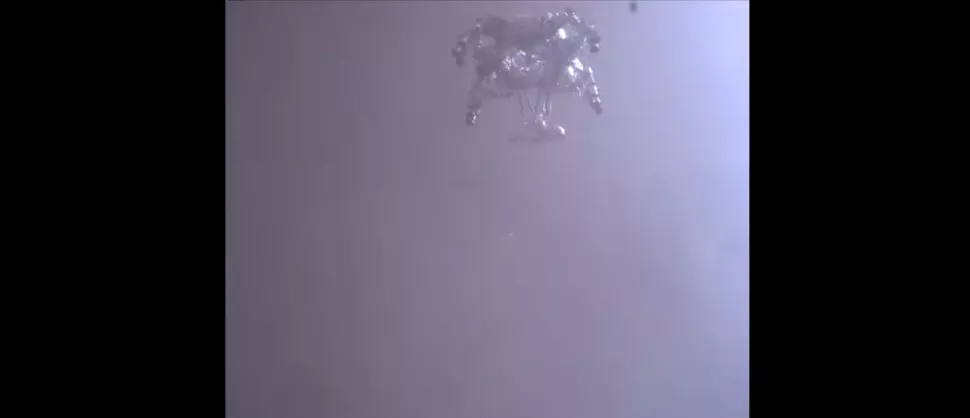The rover captured Mars' first true sounds.
NASA just released impressive, highly established footage, captured on Thursday during its epic landing in the Mars' Jezero Crater by its car-sized Perseverance rover (Feb. 18).
The unparalleled picture brings spectators to the terrifying trip of Perseverance and demonstrates also the moment in which the rover, still linked with his descent process of "sky crane" reached the red dirt on the floor of Jezero.
"Today (22 February) when the entry, descent and landing (EDEL) picture was unveilled to anyone wondering whether you're landing on the Mars, or why it's so complicated, or how cool it would be — look no further," intermediate NASA administrative Steve Jurczyk said in a statement.
"Perseverance is just getting started and already has provided some of the most iconic visuals in space exploration history," added Jurczyk. 'To build and fly a vehicle to the Red Planet reinforces the remarkable degree of engineering and precision necessary.
The EDL camera system in Perseverance also has a microphone, which the team hoped would record the Martian winds and other EDL sounds. But the mic turned on and registered the first-ever sound on the surface of another planet after touchdown This did not happen.
The first robot to log his appearance on Mars isn't perseverance. In August 2012, NASA's predecessor of the six-wheeled robot, Curiosity Rover, took pictures of his own seven-minute touchdown. The journey down is risky in many respects, hence the term. (NASA takes about seven minutes to get to the surface after reaching the top of the Martian atmosphere.)
Curiosity used, among other things, a supersonic parachute and a rocket-powered sky grid to get back safe, to the same fundamental landing technique as Perseverance. But EDL video from the earlier rover was less sharp or complete than what NASA today had revealed.
For eg, we had to see Curiosity's heat shield fall off but the pictures stopped long before the rover struck. And we didn't get the range of views provided by the video Perseverance. The newer mission put several EDL cameras on the back cover of the rover, one on the base of the sky crane and two on Perseverance — one that looked up and one that looked down.
Throughout the descent of Perseverance on Thursday the members of the team have collected more than 23,000 photos. A number of the photos were stitched together to produce a video that starts in the seven-minute terror of the rover for about 230 seconds.
The Perseverance EDL leads Al Chen from NASA's Jet Propulsion Laboratory (JPL) in southern California, said in a news conference today, "These video and these pictures are the stuff of our dreams."
For years to come, Chen and his colleagues are gaining insight into the film that will help Mars' potential landing efforts. And the effect of the video will go far further than engineering and space science groups, which encourage ordinary people from all over the world, NASA officials said.
Thomas Zurbuchen, NASA's associate director of the Science Mission Directorate, said during today's news conference, "What we saw here today is very incredible.' "That video, I believe, should become mandatory viewing for young people who not only want to explore other worlds and build spacecraft to take them there but also want to be part of diverse teams achieving all the audacious goals of our future."
The comprehensive EDL imagery also helped scientists quickly pinpoint where Perseverance's accessory pieces touched down. On Friday (Feb. 19), NASA's Mars Reconnaissance Orbiter, which has been circling the Red Planet since 2006, imaged the mission's backshell and connected parachute, its sky crane, and heat shield, and the rover itself, in their various locations inside Jezero.
Sounds From Mars
And the microphones are there. The EDL mic, and one in its SuperCam rock-zapping unit, is two-fold.
Taking Mars microphones is not new; NASA's spacecraft Mars Polar Lander spore a microphone and the Agency's lander Phoenix had one integrated in his downhill camera. However, none of those instruments gave back any sounds of Mars. In the touchdown attempt in December 1999 Mars Polar Lander crashed and Phoenix's microphone never switched on because its use could impair the landing of the spacecraft. (For a successful surface mission in May 2008, Phoenix was safely impacted.)
But now we have our first ever true Martian audio, thanks to EDL mics from Perseverance. NASA officials also said that on Saturday (Feb. 20) the commercial, off-the-shelf microphone captured about sixty seconds of sound, including a slight Martian breeze and a few whirls of Perseverance.
Perseverance EDL camera lead Dave Gruel, also a JPL, said at today's news conference after playing the sound of the historic Martian snippet, "Really neat — overwhelming, if you will,"
The team continues to work on why the microphone didn't perform as expected for EDL, said Gruel. But initial analyzes indicate a kind of communication issue could emerge involving the "digitizer puck," of the mic, which enables the system to communicate with the onboard computer of Perseverance.
"We're not exactly sure why it happened," said Gruel. "It could have been the fact that there was just so much data streaming into the system."
But it is now working and Gruel and his fellow workers plan to continue to collect audio while it is still on the rugged, cold Martian floor. Perseverance could also collect stereo sonic music at some stage and conduct concert mics from EDL and SuperCam, Team members said.
Speed up for perseverance
Persistence has still not been prepared to start seriously its science work; the rover instrumentation and subsystems are still being tested by the Mars 2020 team. The news on this front is really positive so far.
Jessica Samuels, also of JPL, which manages the Mars 2020 Mission, said during today's News conference "I am happy to say Perseverance is safe.
The team has already carried out 5000 rover controls on the floor, added Samuels, and all "come back exactly how we've been wanting it to with respect to our health checkouts and our instrument checkouts."
The nuclear Perseverance had its headlike mast already deployed and captured its first photo using a powerful imagery device from MastCam-Z. With its danger avoidance and navigation cameras, the rover has also captured several more photos of its surroundings, said mission team Members.
Perseverance will streamline its wheels in the coming days, deploy its robotic arm, and carry out the first run, said Samuels. And the squad proceeds to take off on the surface for the first major mission – taking naiveté to the skies.
Such demonstration flights will likely take place this Spring, which will allow Perseverance to begin science and sample work early this summer.
It should take plenty of time to do it all. The Prime Mission of Mars 2020 is around one month, or 687 days, in March 2020. The rover will continue to drive well into the future; interest still remains today after all.
Source Space.com
Video courtesy ABC News and Video From space



































Comentarios